How to Set Up Ecommerce Tracking in Google Analytics
Would you like to track eCommerce sales data for your online store?
By setting up Google Analytics for an eCommerce site, you can view the number of transactions and revenue your online store generates.
In this article, we'll show you how to set up Google Analytics eCommerce tracking in WordPress.
Start Tracking eCommerce Performance Today!
MonsterInsights is the best WordPress Analytics plugin. Get it for free!
What is Google Analytics eCommerce Tracking?
Google Analytics eCommerce tracking is a feature in Google Analytics that gives you access to a lot of data about what your visitors are doing in your online store. Google Analytics can track several ecommerce metrics, such as overall revenue, number of orders, average order value, add to cart events, and more. Let's take a look at a few benefits of tracking eCommerce sales in Google Analytics:
- Track the performance of your sales and revenue.
- Optimize your conversion funnel to boost sales.
- Get important Key Performance Indicators (KPI) that are vital to your business like average order value, eCommerce conversion rate, per session value, bounce rate, and more.
- Make data-driven decisions to generate more sales and revenue from your eCommerce store.
How to Track Sales with Google Analytics eCommerce Tracking
Before go on to the steps, do note that you'll need MonsterInsights, as it's the best plugin for Google Analytics on WordPress.
It helps in setting up Google Analytics tracking code on your site and offers advanced features, including form submissions tracking, eCommerce tracking, and more.
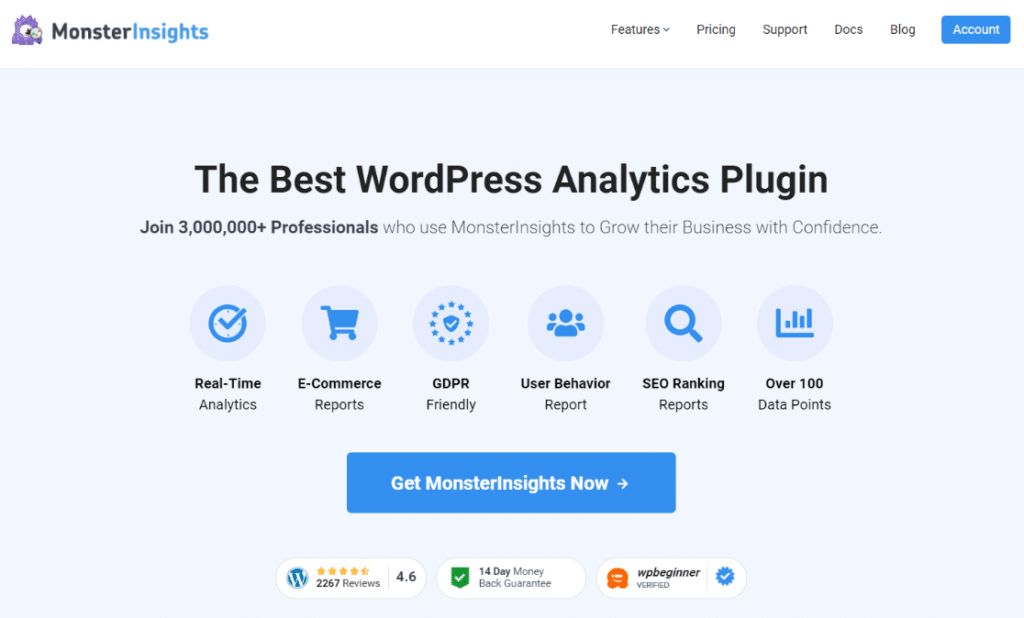
You'll also need the MonsterInsights eCommerce addon on your site. To access the addon, you must have the Pro license plan.
Now, are you ready to learn how to add eCommerce tracking to Google Analytics and WordPress?
Just follow these steps and you'll be tracking sales from your eCommerce store in Google Analytics in no time.
Step 1: Install MonsterInsights WordPress Plugin
If you haven't installed the MonsterInsights yet, you'll need to install it and authenticate it with your Google Analytics account.
To start, download the ZIP files from your account area under the Downloads tab.
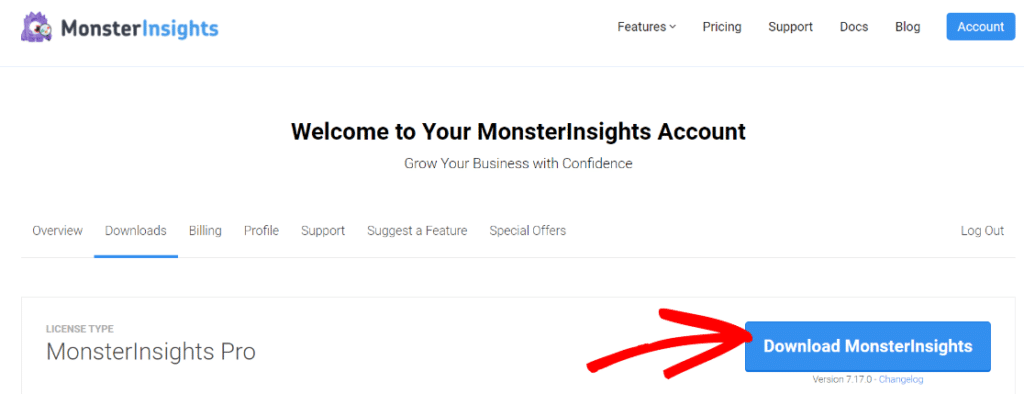
Next, upload the plugin to your WordPress website. You can do that by going to Plugins » Add New » Upload Plugins and clicking the Install Now button.
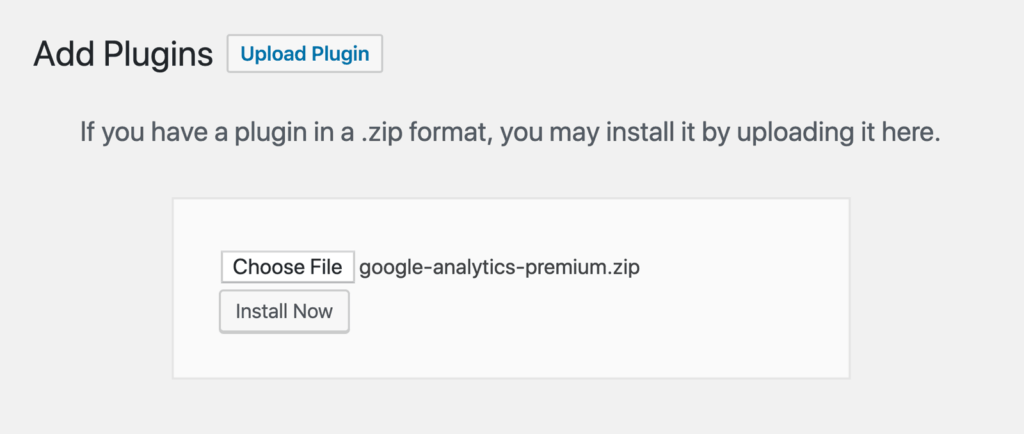
After that, click the Activate Plugin button.
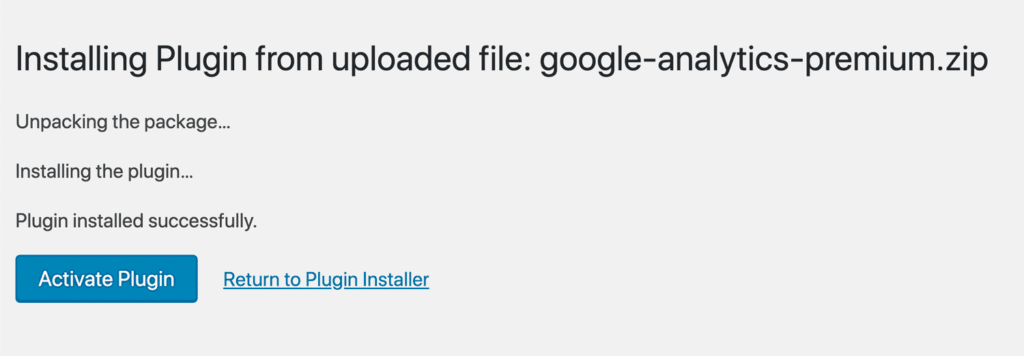
Now, you'll need to connect Google Analytics to your WordPress website. Using MonsterInsights, it's a walk in the park. Just follow the steps in its setup wizard and the plugin will add Google Analytics to your site without the need to edit code.
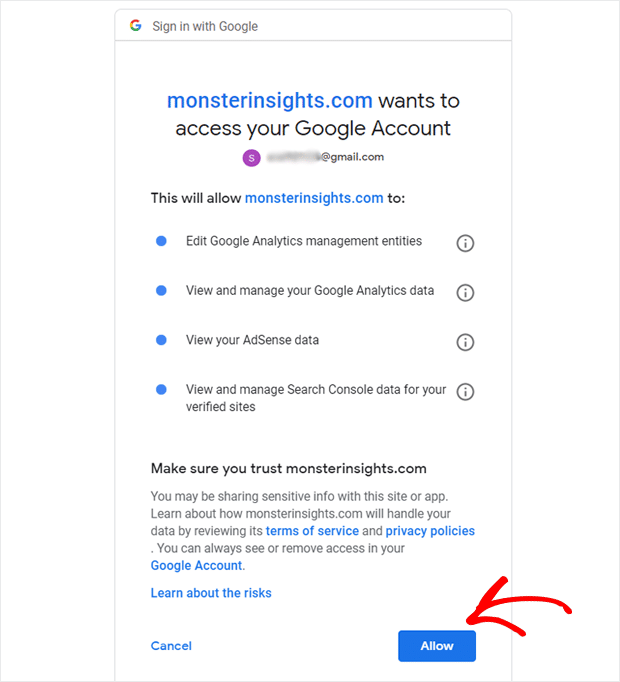
For help getting started, you can read our step-by-step guide on how to properly set up Google Analytics and MonsterInsights.
Step 2: Install the eCommerce Addon
To access the eCommerce addon, you must have the Pro license plan. Need help? Glance through this post on how to upgrade your MonsterInsights license.
Then, go to Insights » Addons and click Install under the MonsterInsights eCommerce addon. After installing it, you'll be prompted to activate it. Go ahead and click the Activate button to make sure the plugin is active and ready to use.

Step 3: Enable eCommerce Tracking in Google Analytics
Now that you've activated the eCommerce addon on MonsterInsights, the next thing to do is turn on Enhanced Ecommerce in Google Analytics.
First, log in to Google Analytics and select the correct website you'd like to enable eCommerce for.
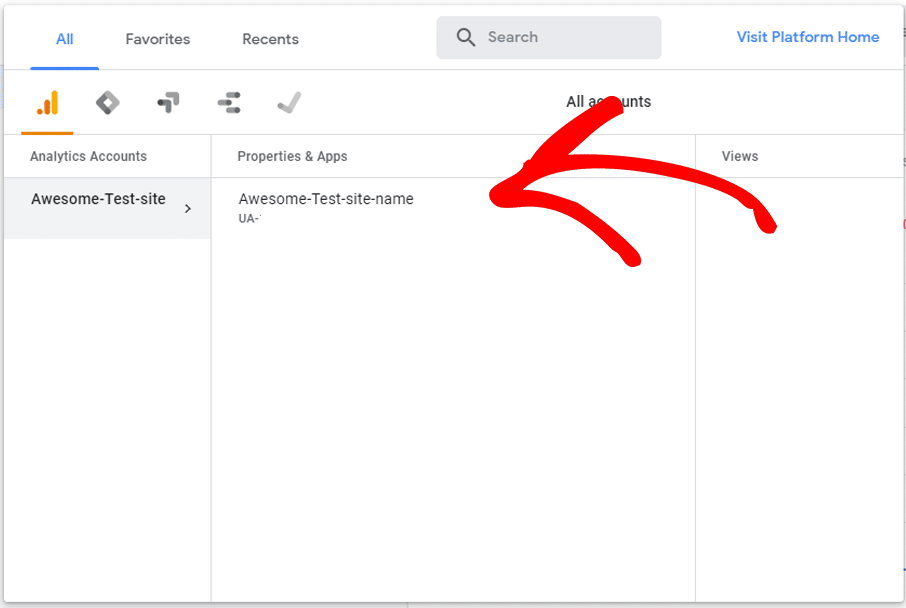
Next, click Admin in the right-hand menu bar.

Now you can click Ecommerce Settings under the column on the right.
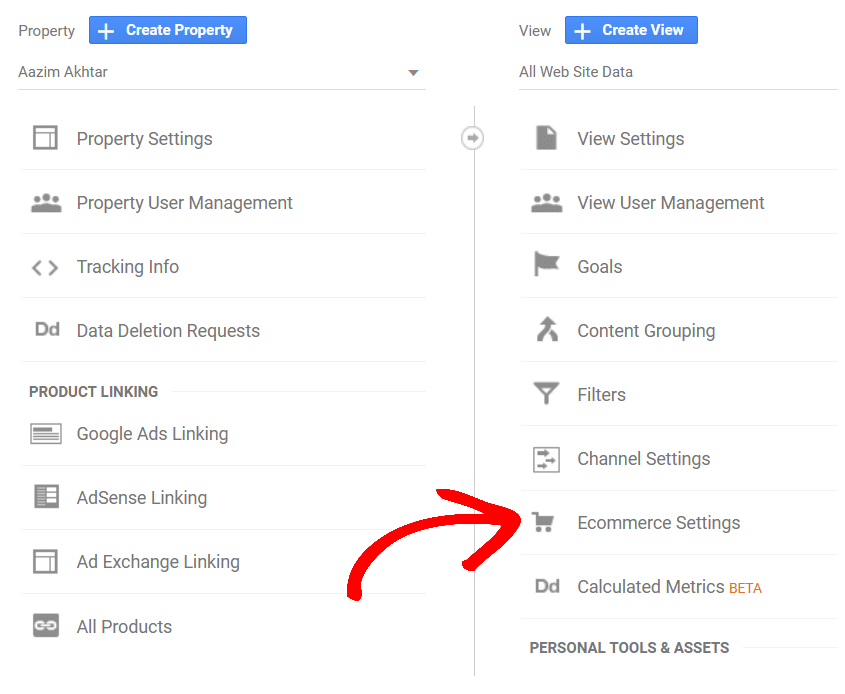
Next, click the slider for Enable Ecommerce and Enable Enhanced Ecommerce Reporting to turn it from off to on.
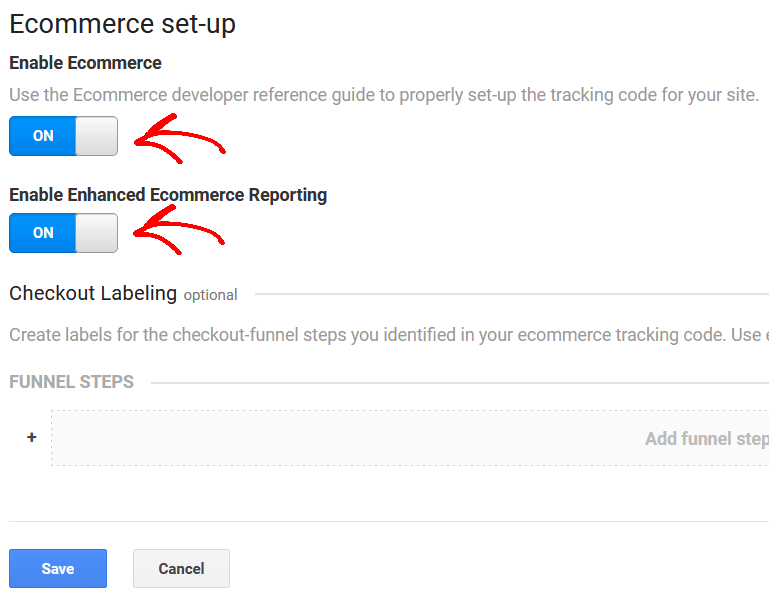
Then click the Save button when you're done.
Step 4: Use Enhanced eCommerce in MonsterInsights
Next, go back to your WordPress website to enable Enhanced eCommerce in MonsterInsights.
You can do that by navigating to Settings » eCommerceand enable Use Enhanced eCommerce.
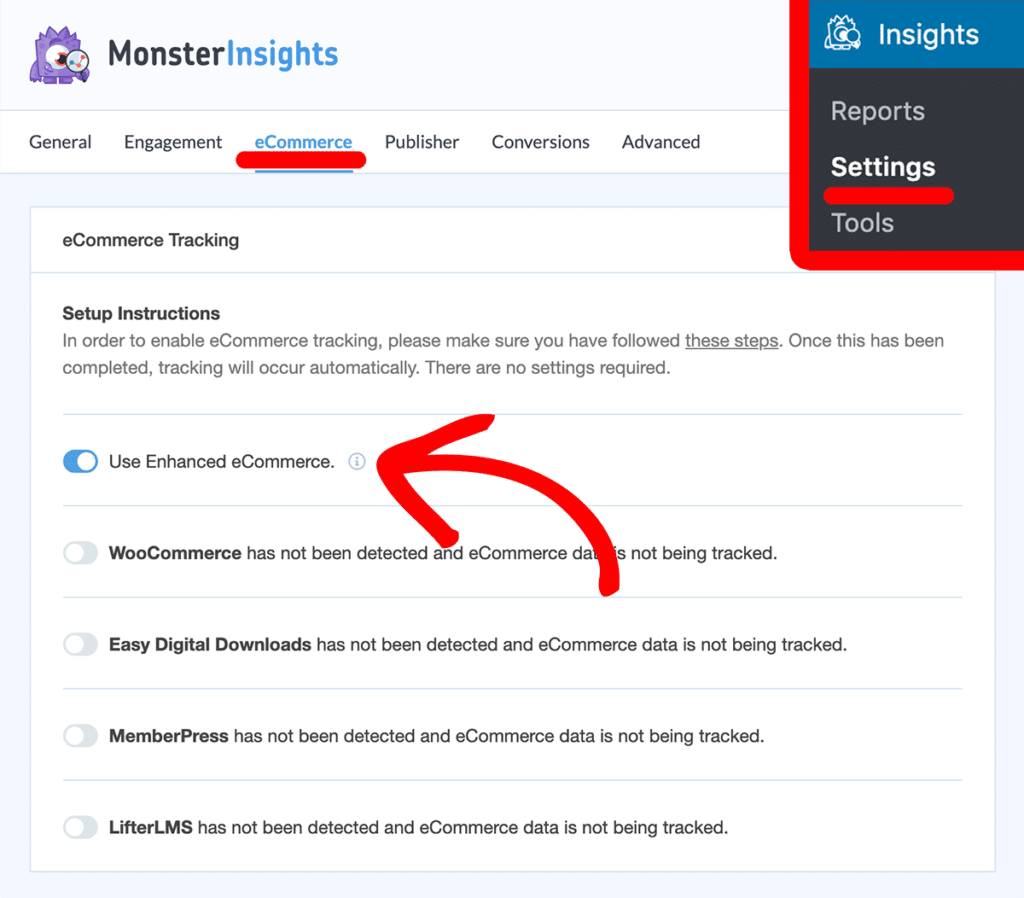
Now tracking will occur automatically without any further configuration of the MonsterInsights settings.
To recap…
How to Set Up Google Analytics eCommerce Tracking: A Checklist
- Download and Install MonsterInsights
- Activate the eCommerce Addon
- Enable Enhanced eCommerce Tracking in Google Analytics
- Enable Enhanced eCommerce Tracking in MonsterInsights
- That's it! You touched no code and eCommerce tracking is now happening. Congrats!
Where To See Google Analytics eCommerce Reports
Once you've completed the setup, MonsterInsights will gather your eCommerce site's data and provides you with highly comprehensive reports about your eCommerce analytics.
Best of all, you can see your most important eCommerce reports right inside your WordPress site dashboard.
To view your eCommerce stats, you'll need to visit Insights » Reports from your dashboard and then click the eCommerce tab. Now you can your eCommerce store's sales data.
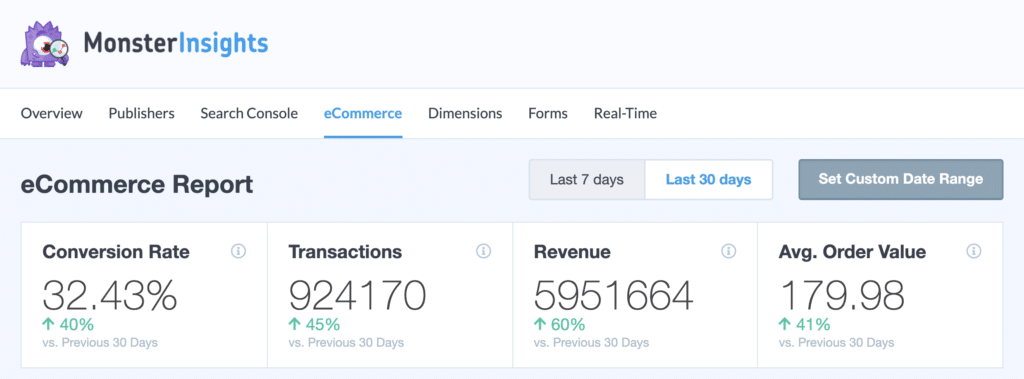
You can see your store's total transactions, conversion rate, revenue, and average order value. You can also see your top-selling products.
As you scroll down the page, you'll see your store's top conversion sources. These are traffic sources that send customers to your website.
While other reports are useful for analyzing your customers' shopping behaviors, like how many items they add to their shopping carts and how many they remove.
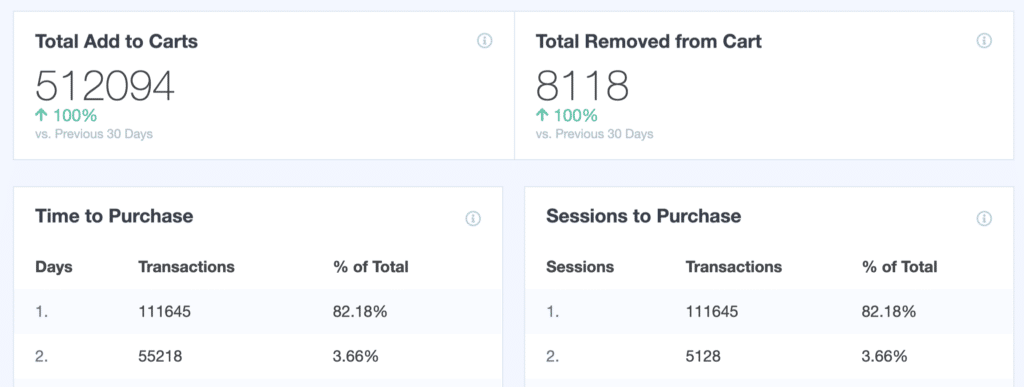
Besides that, MonsterInsights also helps you view Google Analytics time to purchase and sessions to purchase metrics. It shows the time it takes for a customer to complete a transaction.
If you want to see these reports in detail, you can click the View Your Report button at the end of each report. Clicking on the button will take you to the Google Analytics platform. Then, you can explore your Google Analytics eCommerce reports.
To view Google Analytics eCommerce sales (number of transactions) and revenue data, navigate to Acquisition » All Traffic » Source / Medium.
Then click on E-commerce under the Explorer tab. In the table, you'll see multiple columns, including revenue and transactions.
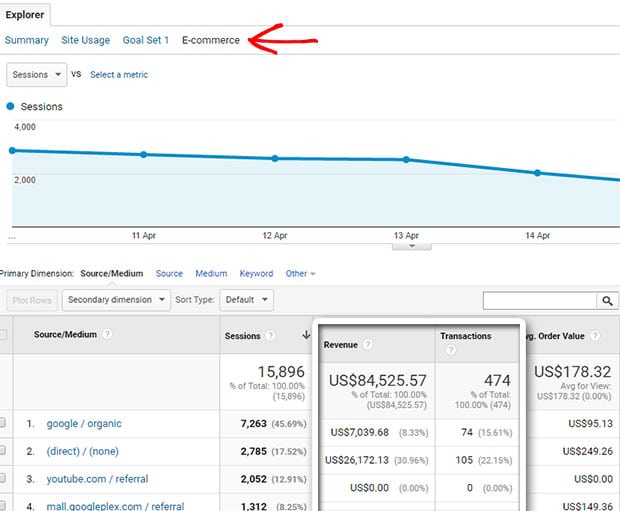
Now let's look at some FAQs about Google Analytics eCommerce tracking.
Frequently Asked Questions About Google Analytics Ecommerce Tracking
Here are some questions that are commonly asked by users about eCommerce analytics tracking.
1. How do I use Google Analytics for eCommerce?
To use Google Analytics for eCommerce is straightforward. WordPress users can sign-in to their Google Analytics account and then click on Admin. Now, under the View column, click eCommerce Settings.
Next, under the Enable Ecommerce status, click to switch it on. Once this is done, click Submit to save the settings.
2. What is the eCommerce conversion rate in Google Analytics?
The ecommerce conversion rate in Google Analytics is the number of transactions to sessions on your store. It's expressed as a percentage and shows how many people purchased your products.
For instance, if 1 transaction is made over 10 sessions, then it would mean your eCommerce conversion rate is 10%. Each transaction has a transaction ID to differentiate it from one another.
3. What is Enhanced Ecommerce Reporting?
Enhanced Ecommerce or EEC is a Google Analytics plugin that gives you in-depth insights about your user's shopping behavior. An easier way of getting this plugin and using it is through MonsterInsights.
Using the eCommerce addon, you can track every detail of your WordPress WooCommerce, LiftLMS, MemberPress, and Easy Digital Downloads store.
4. Why Do You Need Ecommerce Tracking?
Ecommerce tracking helps you find out the performance of your online store. It tracks your sales and revenue, along with other metrics like your most popular product.
Through eCommerce tracking, you can optimize your store to maximize sales and use the data to make better decisions.
5. What is an Ecommerce Transaction?
Ecommerce transaction is buying and selling products using a digital platform. To complete an eCommerce transaction, you don't have to visit a store physically. Instead, you can make a purchase by paying online at checkout.
For example, purchasing products from a WooCommerce or Shopify store is an eCommerce transaction.
6. Which Ecommerce Reports Option Is Right for You?
You can use Google Analytics to view your eCommerce reports. But the best option is to get hold of MonsterInsights and its eCommerce addon.
That way, you can view your eCommerce reports in your WordPress dashboard. You won't have to leave your website and get all your data in one place.
That's it!
You now know how to set up eCommerce tracking in Google Analytics and can easily track the performance of your online store.
Start Tracking eCommerce Performance Today!
Thanks to MonsterInsights, you don't need to perform any manual configuration, as you would need in Google Tag Manager. The WordPress plugin takes care of everything and automatically tracks your eCommerce store's sales and revenue.
We hope you liked our guide on how to set up Google Analytics eCommerce tracking in WordPress. If you're looking to track sales and revenue from your store, you can read our guide on WooCommerce conversion tracking.
And don't forget to follow us on Twitter, Facebook and YouTube for more helpful Google Analytics tips.
How to Set Up Ecommerce Tracking in Google Analytics
Source: https://www.monsterinsights.com/how-to-track-ecommerce-sales-in-google-analytics/